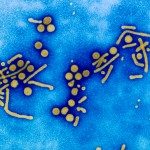Link to Pubmed [PMID] – 17517063
Cell. Microbiol. 2007 Oct;9(10):2445-56
The host-virus interactions leading to cell infection with hepatitis C virus (HCV) are not fully understood. The tetraspanin CD-81 and human scavenger receptor SR-BI/Cla1 are major receptors mediating virus cell entry. However, HCV in patients’ sera is associated with lipoproteins and infectious potential of the virus depends on lipoproteins associated to virus particles. We show here that lipoprotein lipase (LPL), targeting triglyceride-rich lipoproteins (TRL) to the liver, mediates binding and internalization of HCV to different types of cells, acting as a bridge between virus-associated lipoproteins and cell surface heparan sulfate proteoglycans (HSPG). The dimeric structure and catalytic activity of LPL are required for LPL-mediated HCV uptake to cells. Unexpectedly, exogenous LPL significantly inhibits HCVcc infection in vitro. This effect is prevented by anti-LPL antibodies and by tetrahydrolipstatin (THL) a specific inhibitor of LPL enzymatic activity. In addition, we show that antibodies directed to apolipoprotein B (ApoB)-containing lipoproteins efficiently inhibits HCVcc infection. Our findings suggest that LPL mediates HCV cell entry by a mechanism similar to hepatic clearance of TRL from the circulation, promoting a non-productive virus uptake. These data provide new insight into mechanisms of HCV cell entry and suggest that LPL could modulate HCV infectivity in vivo.

